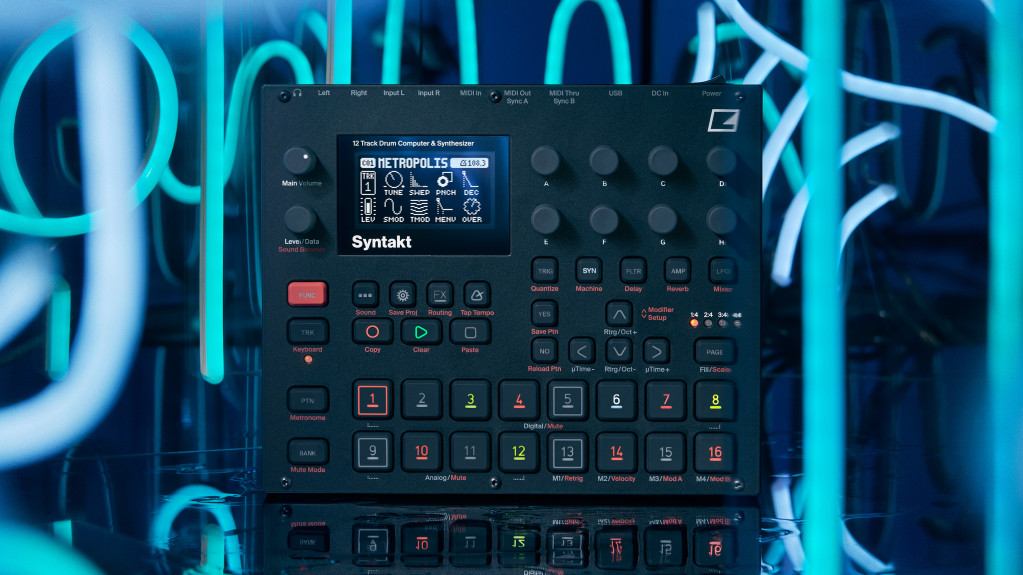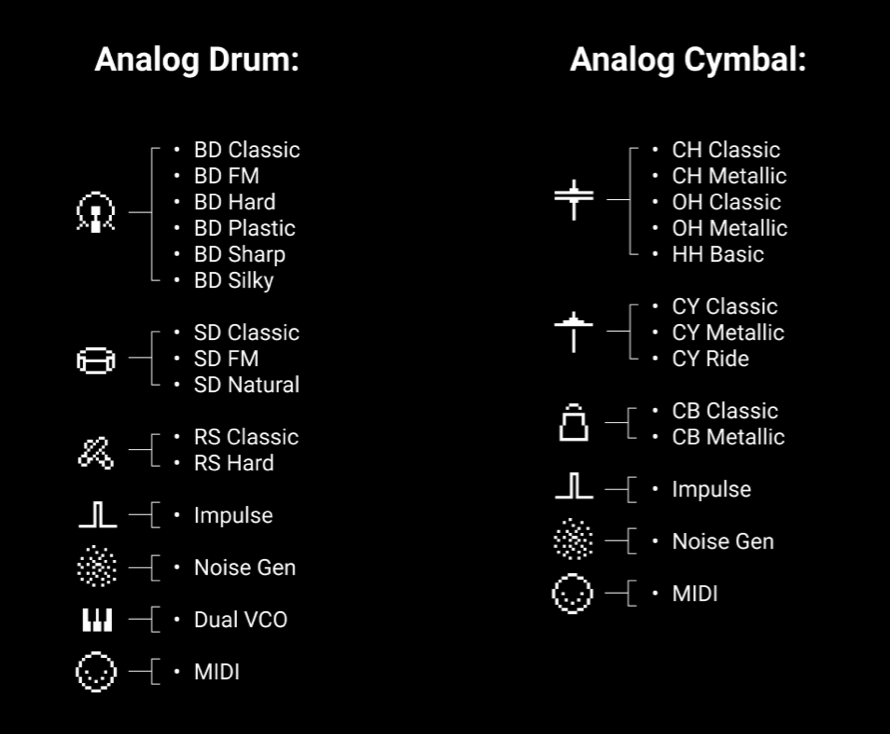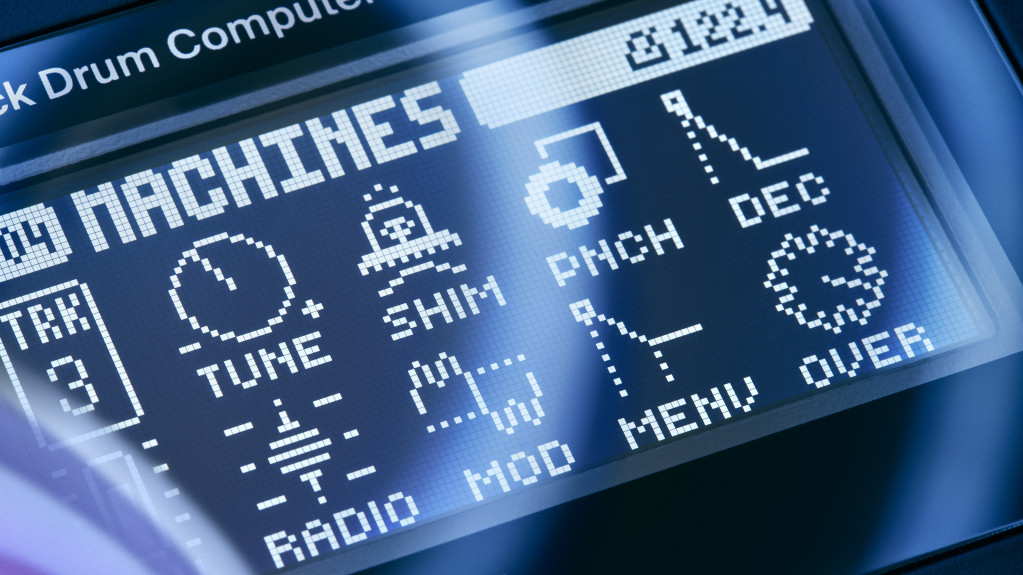Syntakt, launched today, promises to be something special – all the kinds of stuff you love about Elektron boxes, with new capabilities and a fresh approach.
On a basic level, this is a simple and logical follow-up. Digitakt was a “drum computer” and sampler. Digitone was an FM synth. Syntakt is the drum synth, with digital and analog tracks.
In other words, it’s Elektron’s hot hatchback, tricked out and ready to drift.

Or if you don’t like cars, uh… it’s the nimble speedboat. The… uh… cooler flying fighter you fly out of the base ship? I dunno.
Hands-on video
Here’s our friend Adam Jay – one of our favorite techno/electro producers and machinologists – going deep into patterns. (Thanks Adam!)
Analog and digital engines

It’s just a really nice box of all your favorite stuff. It’s multi-engine digital plus multi-engine analog (including an analog cymbal engine). So there are ten machines in the Digital tracks – three of them:
1x Bass drum
2x Snare
1x Cymbal/hat
1x Percussion
1x Clap
4x Tonal synth
And wait – there’s more. A physical modeling synth engine, plus a chip-style lo-fi synth are among the tonal synth options.
Each track has digital overdrive, multimode filter, and base-width filter, plus two LFOs each.

Nice, right? And then you add the Analog Drum track features – fifteen selectable machines for three more tracks:
6x Bass drum (yes, six, each with different models and parameters)
4x Snare (hard, FM, etc.)
2x Rimshot
1x Dual VCO synth
1x Impulse
1x Noise generator
All the “drum” parts, of course, you can think of as general-purpose synthesizers, not only the dual VCO, etc. And the analog parts have multi-temperature tuning onboard plus fine-tuning controls.

Plus there’s one dedicated Analog Cymbal track, with:
5x Hihats
3x Cymbals
2x Cowbells
1x Impulse
1x Noise generator
The analog Cymbal and Drum tracks also boast up to two LFOs per-track, and replace the digital stuff with an analog overdrive and analog multimode filter per-track.
Any number of those twelve tracks (digital or analog) can also be switched to a MIDI machine.

Effects
There are a ton of effects features, too: delay, reverb, analog stereo overdrive, and analog stereo multimode filter, plus 2X LFOs.
You can assign these to each track, but you can also use an external input. The Syntakt is just as plausible a multi-effects box as a synth, or make it a combo of the two.
There’s Send Reverb and Delay, too.
But – maybe this isn’t obvious, you can route anything through the ANALOG FX BLOCK, both internally and externally.
Yeah, it’s the hub of your rig if you want
Honestly, for everyone who’s been waiting for a new Elektron box they can use as the hub of a live rig, there’s absolutely no reason not to think this is finally it. Sure, it’s more square-ish than rectangular, for long-time Elektron purists, but – holy crap, it’s loaded. 4-note polyphony per step, 8x assignable CC controls, 1x LFO per track – okay, it’s not a complete sequencer, but the combination of multi-engine internal sound machines, external audio processing, analog and digital, and 6 tracks with MIDI mean it could absolutely be at the center of some other stuff.
And naturally, all the usual performance features are there with trig conditions and trig chance and retrig and micro timing. In short, your sequences can be creative and non-repetitive/not overly square. And you get +DRIVE and the normal project / pattern / sound pool approach, all of which gets very familiar as you start to work with more Elektron stuff, especially thanks to recent (needed) improvements to their Transfer app.

There’s also a decent array of keyboard scales, similar to what you get in tools like Ableton Push. I just wish hardware manufacturers had better support for tuning – especially when you see (essentially mislabeled) “PERSIAN,” “PELOG,” and whatnot. (Well, Pelog is close, but yeah.) Maybe we can figure out a way to have some little tuning box to plug into this thing.
Just saying it has LFOs doesn’t really tell the whole story. You can route those LFOs to pretty much anything – CCs, amplifier, filter, waveform, trig mode, reverb and delay parameters, and so on. A ton of controls are also MIDI CC-addressable.

What a nice package
I really look forward to sharing the finished hardware – and I’d rather get into esoteric sound design features and the like! But as you’ll see in launch-day videos, it just looks really nice. Colors and lights have been toned down and made more appealing, the OLED looks great and is way easier to read, and there are just lots of little clever visual details and animations. I think it’s not a stretch to say this is the first Gothenburg box to earn a little envy from that other Swedish electronics maker; these are visuals worthy of an OP-1 or Pocket Operator.
All of this has class-compliant USB audio and MIDI and Overbridge (though I find myself not even needing Overbridge once I have the rest, personally).
I still don’t love those Elektron pads; I’d much rather have something tighter. But otherwise, look and feel are great.
Obviously, Elektron will want this to be a companion to other boxes of theirs, but it also embodies and extends a lot of the better stuff. It has the depth of the DIgitone and Analog Four, but it honestly reminds me of a lot of the accessibility and natural improvisation of the Model:Cycles and Model:Samples – combining their immediacy with the greater sonic depth of their bigger siblings.
https://www.elektron.se/products/syntakt/
Watch for a full review shortly. I may gush more about the Model: series, too, as I think they’re great – but even as good as the Digitakt and Digitone are, this is the first ‘takt that feels like the right model to upgrade to for more sonic powers.
Stay tuned for more. There are lots of boxes out there, but some boxes come along only so often.